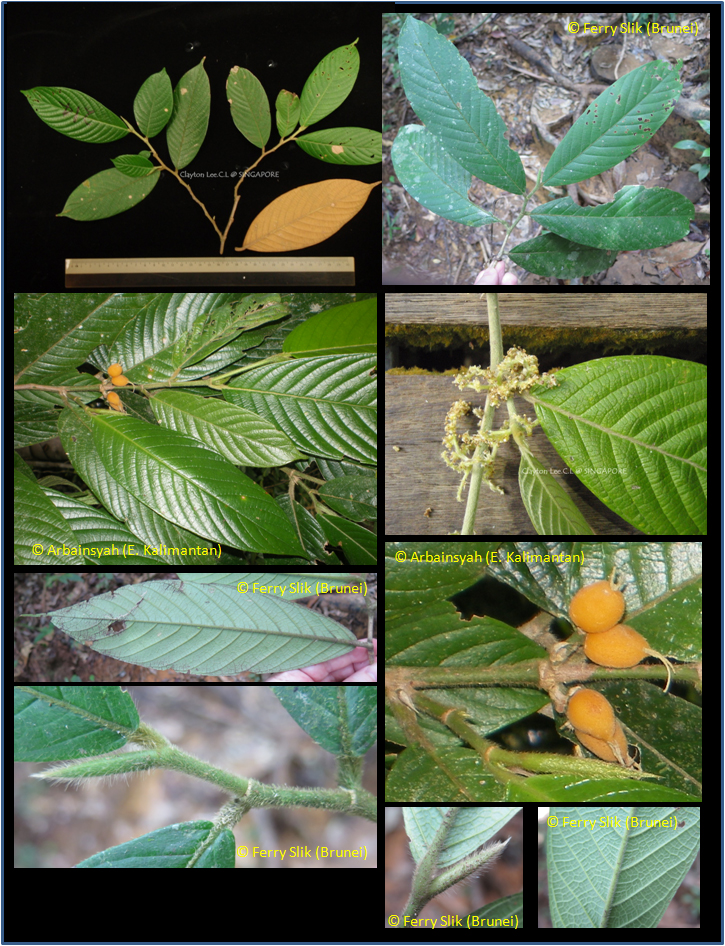Gironniera nervosa Planch., Ann. Sc. Nat. 3, 10 (1848)
Latin for 'clearly veined', referring to the leaf venation.Synonyms
Antidesma nervosum Wall. [Invalid]
Gironniera hirta Ridl.
Gironniera penangiana Gandog.
Gironniera sponioides Gandog
Diagnostics
Mid-canopy tree up to 40 m tall and 64 cm dbh. Stipules ca. 25 mm long,
leaving ring around the twig when dropped. Leaves alternate, simple, penni-veined,
densely hairy, base unequal. Flowers ca. 1 mm diameter, white, placed in
(branched) racemes. Fruits ca. 6 mm long, yellow-orange-red, drupes.
Description
Small to large-sized tree up to 40 m, 64 cm diameter. Buttresses sometimes present, low.
Bark smooth or finely fissured, grey-green to dark grey-brown, often hoop-marked and lenticellate.
Terminal bud 1-2 by 1/4-1/2 cm; stipules 1.5-2 by 1/4-1/2 cm. Leaves thick-coriaceous, rigid,
elliptic-lanceolate to elliptic-oblong, (6.5-)10-15(-18) by (2.5-)4-6(-8) cm, broadest at the middle,
index 2.5-3; except for the midrib and lateral nerves glabrous above, densely set with yellowish-
brown, soft, slender hairs beneath ; base rounded or attenuate, unequal-sided; margin entire,
often recurved; apex rounded to acute; midrib and nerves strongly raised beneath, flatfish or
impressed above ; nerves (12-)14-16(-17) pairs, 5-8 mm spaced, arcuating but not anastomosing
near the margin, forming an angle of up to 60 degrees with the midrib; reticulations dense,
regularly spaced, scalariform or subscalariform, strongly raised and prominent beneath,
obscure to faintly visible above; petiole 5-10 by 1-2 mm, subterete, densely yellowish-brown
appressed, pubescent. Inflorescences male or female axillary, borne on separate shoots, including
the bracts densely yellowish-brown, appressed-pubescent bracts narrow ovate-acute, c. 1-2 by 1 mm.
Inflorescence a slender, lax, pendent, branched panicle of condensed cymes, up to 7 cm long,
bearing 20-100 flowers; 3 flowers in clusters of 5-10 along the axes, c. 2 by 2 mm; perianth lobes
broad ovate-acute, c. 1-1.5 by 1 mm, densely, short appressed-hairy outside; filaments l-1.5 mm,
anthers ovoid, c. 1 mm diameter; pistillode strongly rudimentary. Female Inflorescence a simple or
branched panicle, up to 2.5 cm long, 5-10-flowered; 9 flowers sessile along the axes, compressed
ovoid-conical, 2-3 by 1.5-2 mm; perianth lobes ovate-acute, densely appressed-hairy outside,
1.5-2 by 1 mm; ovary densely appressed-hairy, 1.5-3 by 1-1.5 mm; stigmatic arms 5-10 mm.
Infructescence up to 3 cm long, bearing (2-)4-6(-8) fruits. Fruit subglobose or ovoid, densely
appressed-pubescent, 5-8 by 4-6 by 3-4 mm, short-beaked. [from Flora Malesiana]
Ecology
In undisturbed to slightly disturbed (open sites) mixed dipterocarp and
swamp forests up to 1300 m altitude. Often on alluvial sites and along rivers and
streams, but also common on hillsides and ridges. On ultrabasic to sandy soils,
but also on clay.
Uses
The wood is used for construction. The fruits are edible.
Distribution
Thailand, Peninsular Malaysia, Sumatra, Borneo, Moluccas and New Guinea.
Local names
Borneo: Ampas tebu, Gagas, Hugot-hugot, Kayu ruas, Kiga, Langitan, Lempung bulu,
Luazon, Mara keladi, Medang kasap, Miang-miang, Pisang-pisang, Puloh, Sosopon
bonging.
Malaysia: Hampas, Hampelas burung, Medang berbulu, Medang kasap, Tapis, Tebu.
New Guinea: Warpis.
